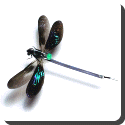 Dragonfly — A dragonfly is an insect belonging to the order Odonata, the suborder Epiprocta or, in the strict sense, the infraorder Anisoptera. It is characterized by large multifaceted eyes, two pairs of strong, transparent wings, and an elongated body.
Dragonfly — A dragonfly is an insect belonging to the order Odonata, the suborder Epiprocta or, in the strict sense, the infraorder Anisoptera. It is characterized by large multifaceted eyes, two pairs of strong, transparent wings, and an elongated body.
Dragonflies typically eat mosquitoes, midges and other small insects like flies, bees, and butterflies. They are usually found around lakes, ponds, streams and wetlands because their larvae, known as “nymphs”, are aquatic. Dragonflies do not normally bite or sting humans, though they will bite in order to escape, if grasped by the abdomen. They are valued as predators that help control populations of harmful insects, such as mosquitoes. Dragonflies are one of several insects commonly referred to as “mosquito hawks” in North America.
Dragonflies are capable of hovering followed by rapid acceleration. Some nymphs even hunt on land, an aptitude which could easily have been more common in ancient times when terrestrial predators were clumsier. Giant dragonflies can glide 20 meters at 10 degrees and a velocity of 74 cm per second which is similar to some birds. They capture their prey by clasping them in legs studded with spikes. Prey can not escape by diving away because dragonflies always attack from below.
Female dragonflies lay eggs in or near water, often on floating or emergent plants. When laying eggs, some species will submerge themselves completely in order to lay their eggs on a suitable surface. Most of a dragonfly’s life is spent in the larval, (naiad, aka nymph) form, beneath the water’s surface, using internal gills to breathe, and using extendable jaws to catch other invertebrates or even vertebrates such as tadpoles and fish. The larval stage of large dragonflies may last as long as five years. In smaller species, this stage may last between two months and three years. When the larva is ready to metamorphose into an adult, it climbs up a reed or other emergent plant at night. Exposure to air causes the larva to begin breathing. The skin splits at a weak spot behind the head and the adult dragonfly crawls out of its old larval skin, waits for the sun to rise, pumps up its wings and flies off to feed on midges and flies. The adult stage of larger species of dragonfly can last as long as four months.
 Kids Portal For Parents India Kids Network
Kids Portal For Parents India Kids Network
